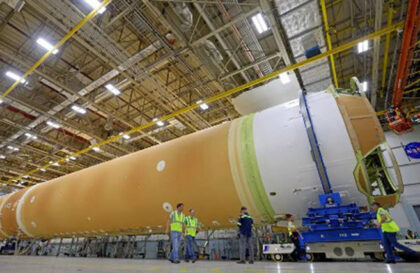Before departing from Earth, Artemis astronauts traveling to the Moon will receive a luxurious view of the transport to the launch pad.
NASA recently showed off the polished interior of its new fleet of three transport modes for astronauts from Canoo Technologies Inc. These vehicles are intended for use in the Artemis program, and the first astronaut crew, Artemis 2, will have the opportunity to use all-electric vehicles before the start of the mission to the moon in 2024.
The interior of the lunar crew car was unveiled during the United States Formula One (F1) Grand Prix in Austin, Texas. This event took place from October 20 to 22. Both Reid Wiseman (a NASA astronaut) and Jeremy Hansen (a representative of the Canadian Space Agency) attended the event on October 22. They were there to chat with the race crews.
On launch day, each crew vehicle will travel approximately nine miles (equivalent to 14 kilometers) at the Kennedy Space Center (KSC) under NASA supervision. According to a statement from NASA officials in 2022, Canoo was tasked with developing a project to produce three vehicles with eight seats each and operate on zero-emission technology, all for the benefit of the next generation of explorers.
During a dress rehearsal last month, the Artemis 2 astronauts said they would dress up in Neil Armstrong’s operations building and cashier. The four astronauts, including NASA’s Christina Koch and Victor Glover, will be escorted by supporters before they head to launch pad 39B. This place was the final destination for Apollo astronauts and space shuttle crews.
The machines involved in the launch are used not only during this event but also in various other pre-launch activities, such as launch dress rehearsals and training. In addition, astronaut crews are currently receiving assistance from other Navy services. For example, while SpaceX uses Tesla as support for its Crew Dragon missions to the International Space Station, Boeing plans to develop a dedicated Airstream Atlas coach called the Astrovan II for its commercial crew flights.
Transportation of cosmonauts to the launch pads at KSC spanned several generations of vehicles. One example was the modified trailer used by the Mercury 7 astronauts, which was towed by an REO Motor Co. tractor. Similarly, Apollo, Apollo-Soyuz, and early shuttle crews relied on a modified Clark Cortez motorhome for transportation.
In November 1983, the Space Shuttle changed significantly, switching to the legendary Astrovan. Astrovan was responsible for transporting all astronaut crews to the pad between missions STS-9 and STS-135. The Astrovan is currently on display in the KSC Visitor Center.
As Artemis 2 approaches, other activities continue. The crew returned to NASA’s Johnson Space Center for a sixth month of training, focusing on operations in Earth orbit. In addition, simulation exercises involving NASA and the US Navy will soon take place, as announced by NASA officials on October 19. On the same day, the crew and service modules of the Orion Artemis 2 spacecraft were assembled.
As cool as Canoo electric vehicles will transport NASA astronauts 9 miles to the Kennedy Space Center, there’s a good chance they’ll remember their next vehicle much more vividly. After all, the spacecraft they will travel on board will travel more than 240,000 miles to the Moon.
Banner image: NASA
Image credit:
https://www.nasa.gov




